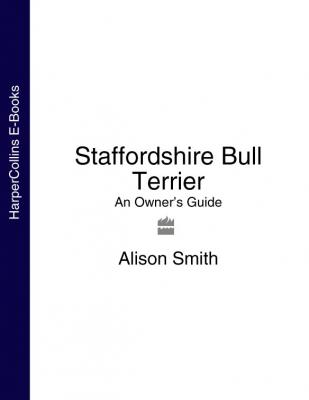ТОП просматриваемых книг сайта:
Staffordshire Bull Terrier: An Owner’s Guide. Alison Smith
Читать онлайн.Название Staffordshire Bull Terrier: An Owner’s Guide
Год выпуска 0
isbn 9780007544301
Автор произведения Alison Smith
Жанр Домашние Животные
Издательство HarperCollins
STAFFORDSHIRE BULL
TERRIER
AN OWNER’S GUIDE
Alison Smith
Healthcare by David Taylor
To the most special people in my life, without whom I would not be what I am now: John Fletcher, Ruth and Willis Ford, my husband Syd, my babies Zara and Asher, Jayne Pashley and Dan-Dan! Also Arlene Fletcher, my Mum, who I miss beyond words.
Contents
Chapter 1 History of the breed
Chapter 3 Socialization and training
Owning a dog is a huge responsibility but extremely rewarding. When you decide to welcome a Staffordshire Bull Terrier into your home, you have to consider not only how he will fit into your lifestyle but also what you can offer him in return. He will need regular exercise, feeding, games and companionship as well as daily care.
The history of the dog known today as the Staffordshire Bull Terrier is, perhaps, one of the most well known histories of any breed. This loyal, people-loving dog still carries with him all the best traits that have been bred into him over the centuries to make him one of the most wonderful family pets imaginable.
Bloodsports
In the early nineteenth century, terriers of all kinds were bred for their ability to take part in what were then known as bloodsports, the two most popular being bull-baiting and cock-fighting. In the mid-1800s, bulls were brought to markets and upon by dogs. Baiting was done for two reasons: to tenderize the bull’s meat and provide entertainment for the spectators, who enjoyed nothing more than watching the specially bred dogs bring down a bull. This pastime also extended to bears and other animals.
These bloodsports were very common at this time and would often take place in villages and at country fairs. The dogs would grab the bulls and be tossed around, sometimes even being hurled over a bull’s head, only to be thrown back into the action by their owners.
Bred to win
The secret to a winning dog’s success lay in the strength of his jaw. The ability to ‘lock’ his jaws onto another animal meant that, no matter how strong the opposition, the steely grip and weight of the dog would eventually tire the bull out and bring it down.
Another trait of the Staffordshire Bull Terrier was (and still is) its incredible tolerance to pain. This meant that they invariably continued to hang on, despite suffering severe injuries.
These early dogs bore no resemblance to the noble breed we are used to today. They were bred not for their pleasing looks but for what was then known as their ‘gameness’ – in other words, their strength and skill against animals which were over 20 times their size.
The Stafford’s fearless nature, together with his in-built resolve never to quit, are still much in evidence in the breed today, although modern breeders are also careful to breed for a good, sound temperament in their dogs, so that they will make good family pets.
The loyal Staffordshire Bull Terrier is one of the most noble looking and wonderful dogs imaginable
Origins of the breed
The modern breed owes much of its physical attributes to the Bulldog. However, the Bulldog of the nineteenth century was a somewhat larger dog than the big-jawed and handsome one of today, with longer legs and a much more refined head, more reminiscent of the American Staffordshire Bull Terrier. The Bulldog is believed to have been crossed with several other terrier breeds in a bid to attain a dog which combined great physical strength in the head and body with an agile swiftness. This was an ideal combination for a dog who was expected to fight in small areas, often known as ‘pits’. These breeds were often referred to as ‘Half-and-Halfs’, in a nod to the two distinct breeds that had produced them. The breed nowadays resembles both the Bulldog and the terrier, with evidence of the former still clearly seen in the head.
The breed nowadays still shows

